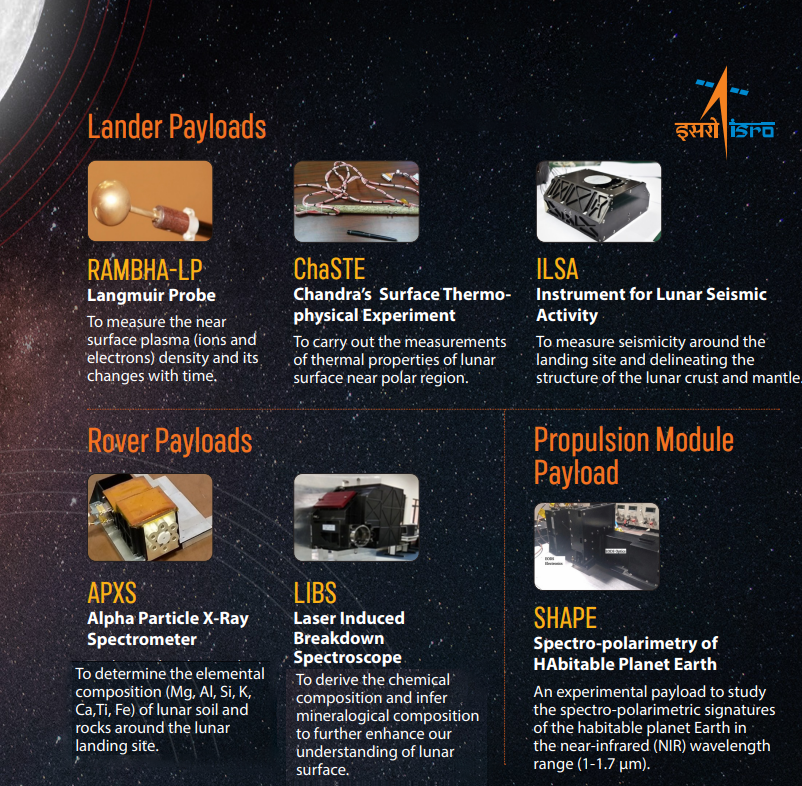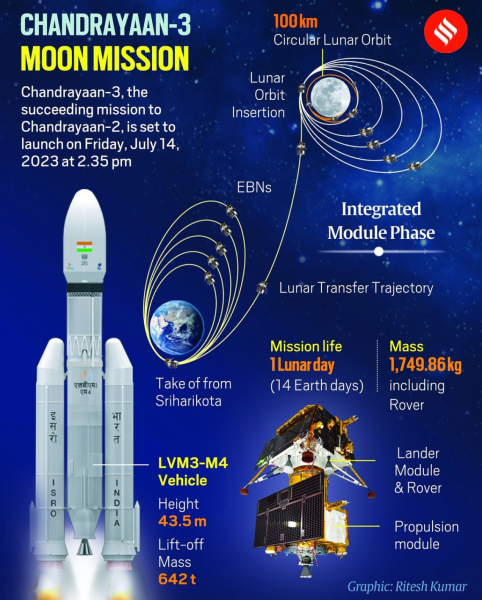Science & Technology
Chandrayaan-3
- 17 Jul 2023
- 8 min read
For Prelims: Chandrayaan-3, Spectro-polarimetry of Habitable Planet Earth, Satish Dhawan Space Center, Elliptic Parking Orbit, LVM3 M4, Flybys, Orbiters, Impact Missions, NASA's Artemis Program
For Mains: Space Technology, Chandrayaan 3 Mission and its Significance
Why in News?
With the launch of Chandrayaan-3, the Indian Space Research Organisation (ISRO) is embarking to achieve a successful soft landing on the moon.
- India aims to become the fourth country in the world to achieve this feat, joining the ranks of the United States, Russia, and China.
What is Chandrayaan-3 Mission?
- About:
- Chandrayaan-3 is India's third lunar mission and second attempt at achieving a soft landing on the moon's surface.
- The mission took off from the Satish Dhawan Space Center (SDSC) in Sriharikota on July 14, 2023, at 2:35 pm.
- It consists of an indigenous Lander module (LM), Propulsion module (PM) and a Rover with an objective of developing and demonstrating new technologies required for Inter planetary missions.
- Mission Objectives of Chandrayaan-3:
- To demonstrate Safe and Soft Landing on Lunar Surface
- To demonstrate Rover roving on the moon and
- To conduct in-situ scientific experiments.
- Features:
- The six payloads on the Vikram lander and rover Pragyan remain the same as the Chandrayaan-2 mission.
- The scientific payloads on the lander aim to study various aspects of the lunar environment. These payloads include studying lunar quakes, thermal properties of the lunar surface, changes in plasma near the surface, and accurately measuring the distance between Earth and the moon.

- The propulsion module of Chandrayaan-3 features a new experiment called Spectro-polarimetry of Habitable Planet Earth (SHAPE).
- SHAPE aims to search for smaller planets with potential habitability by analyzing reflected light.
- The six payloads on the Vikram lander and rover Pragyan remain the same as the Chandrayaan-2 mission.
- Changes and Improvements in Chandrayaan-3:
- The landing area has been expanded, providing flexibility to land safely within a larger designated area.
- The lander has been equipped with more fuel to enable longer-distance travel to the landing site or alternate locations.
- The Chandrayaan-3 Lander has solar panels on four sides, instead of only two in Chandrayaan-2.
- High-resolution images from the Chandrayaan-2 orbiter are used to determine the landing location, and physical modifications have been made to enhance stability and sturdiness.
- Additional navigational and guidance instruments are on board Chandrayaan-3 to continuously monitor the Lander’s speed and make the necessary corrections.
- This includes an instrument called Laser Doppler Velocimeter, which will fire laser beams to the lunar surface to calculate the Lander’s speed.
- Launch and Timeline:
- The LVM3 M4 launcher has been successfully utilized to launch Chandrayaan-3
- Around 16 minutes after the LVM-3 lifted off, the spacecraft separated from the rocket. It entered into an elliptic parking orbit (EPO).
- Chandrayaan-3's journey is estimated to take approximately 42 days, with a landing scheduled for August 23, 2023 at the lunar dawn.
- The lander and the rover will have a mission life of one lunar day (about 14 Earth days) as they work on solar energy.
- The landing site for Chandrayaan-3 is near the lunar south pole.
- The LVM3 M4 launcher has been successfully utilized to launch Chandrayaan-3
What is the Importance of Landing Near the Lunar South Pole?
- Historically, spacecraft missions to the Moon have primarily targeted the equatorial region due to its favorable terrain and operating conditions.
- However, the lunar south pole presents a vastly different and more challenging terrain compared to the equatorial region.
- Sunlight is scarce in certain polar regions, resulting in perpetually dark areas where temperatures can reach to -230 degrees Celsius.
- This lack of sunlight and extreme cold pose difficulties for instrument operation and sustainability.
- The lunar south pole offers extreme and contrasting conditions that pose challenges for humans but it make them potential repositories of valuable information about the early Solar System.
- It is crucial to explore this region which could impact future deep space exploration.
What is India’s Other Chandrayaan Missions?
- Chandrayaan-1:
- India's lunar exploration missions began with Chandrayaan-1 in 2008, which aimed to create a three-dimensional atlas of the moon and conduct mineralogical mapping.
- Launch Vehicle: PSLV – C11.
- Chandrayaan-1 made significant discoveries, including the detection of water and hydroxyl on the lunar surface.
- India's lunar exploration missions began with Chandrayaan-1 in 2008, which aimed to create a three-dimensional atlas of the moon and conduct mineralogical mapping.
- Chandrayaan-2: Partial Success and Discoveries:
- Chandrayaan-2 consisted of an Orbiter, Lander, and Rover, with the goal of exploring the lunar south pole.
- Launch Vehicle: GSLV MkIII-M1
- Although the lander and rover crashed on the moon's surface, the Orbiter successfully collected data and found signatures of water at all latitudes.
- Chandrayaan-2 consisted of an Orbiter, Lander, and Rover, with the goal of exploring the lunar south pole.
Types of Moon Missions:
- Flybys: These missions involve spacecraft passing near the moon without entering its orbit, allowing for observations from a distance.
- Examples include Pioneer 3 and 4 by the United States and Luna 3 by the USSR.
- Orbiters: These spacecraft enter lunar orbit to conduct prolonged studies of the moon's surface and atmosphere.
- Chandrayaan-1 and 46 other missions have utilized orbiters.
- Impact Missions: Extensions of orbiter missions, impact missions involve instruments making an uncontrolled landing on the lunar surface, providing valuable data before being destroyed.
- Chandrayaan-1's Moon Impact Probe (MIP) followed this approach.
- Landers: These missions aim for a soft landing on the moon's surface, allowing for close-quarter observations.
- Luna 9 by the USSR was the first successful landing on the moon in 1966.
- Rovers: Rovers are specialized payloads that detach from landers and move independently on the lunar surface.
- They gather valuable data and overcome the limitations of stationary landers. Chandrayaan-2's rover was called Pragyan( same name is retained for Chandrayaan-3 as well).
- Human Missions: These missions involve the landing of astronauts on the moon's surface.
- Only NASA has achieved this feat, with six successful landings between 1969 and 1972.
- NASA's Artemis III, planned for 2025, will mark humanity's return to the moon.
UPSC Civil Services Examination, Previous Year Question (PYQ)
Q. Discuss India’s achievements in the field of Space Science and Technology. How the application of this technology has helped India in its socio-economic development? (2016)





